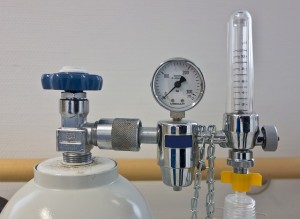 Print a Sign-In Sheet | Spanish Version
Print a Sign-In Sheet | Spanish Version
Oxygen, acetylene, argon, air, liquefied petroleum gas (LPG), nitrogen, and other compressed gases are found in metal cylinders of various colors and sizes.
Cylinders handled and stored in an unsafe manner may cause injury. Cylinders can rupture or explode and are capable of smashing through brick walls. Fires, explosions, oxygen displacement, toxic exposures,and other physical hazards are risks associated with compressed gas cylinders and their high-pressure systems.
REMINDER: Only qualified and properly trained personnel should handle or otherwise work with compressed gas cylinders.
Here are some safety tips for storing and using compressed gas cylinders.
Storage:
- Keep cylinders in an upright and secure position (either on a cart, in a rack, or tied down).
- Store oxygen and fuel cylinders at least 20 feet apart or separated by a 5-foot-high noncombustible barrier.
- Store flammable gas cylinders apart from oxidizing gas cylinders.
- Never leave cylinders standing alone.
- Store cylinders away from highly flammable substances, such as oil and gasoline, and store them away from electrical connections and combustible waste materials.
- Close cylinder valves when not in use and ensure a safety cap is in place.
- Keep oil and grease away from oxygen cylinders to decrease the risk of spontaneous ignition.
- Label empty cylinders and store them in properly designated areas.
- Ensure cylinder storage areas have permanent postings that identify gases stored in the cylinders.
- Clearly mark cylinder exteriors with labels identifying the contents and necessary precautions.
- Ensure cylinder storage areas are dry, cool, and well-ventilated.
- Store cylinders in areas away from incompatibles, excessive heat, dampness, salt, and other corrosive chemicals.
- Ensure cylinders do not block exit paths.
- Regularly inspect cylinders for corrosion, pitting, cuts, gouges, digs, bulges, neck defects, and general distortion.
Use:
- Ensure cylinders are handled only by qualified and properly trained personnel.
- Open valves slowly, using a T-handle wrench or the valve wheel.
- Never use oxygen to blow dust or other debris from your work clothes.
- Never roll cylinders on the ground or other work surfaces.
- Move cylinders via a suitable hand truck.
- Never mix and match acetylene and oxygen gauges.
- Immediately remove leaking gas cylinders from service.
- Check connections, such as pressure regulators, manifolds, hoses, gauges, and relief valves, for integrity and tightness.
- Check all relief devices and connections for indications of tampering.
- Implement procedures to follow when cylinder leaks cannot be remedied by tightening the valve.
- Notify the cylinder vendor, if any, with regard to cylinder alterations, repairs, or problems.
KEMI does not assume liability for the content of information contained herein. Safety and health remain your responsibility. This information is to be used for informational purposes only and not intended to be exhaustive or a substitute for proper training, supervision, or manufacturers’ instructions/recommendations. KEMI, by publication of this information, does not assume liability for damage or injury arising from reliance upon it. Compliance with this information is not a guarantee or warranty that you will be in conformity with any laws or regulations nor does it ensure the absolute safety of any person, place, or object, including, but not limited to, you, your occupation, employees, customers, or place of business.

